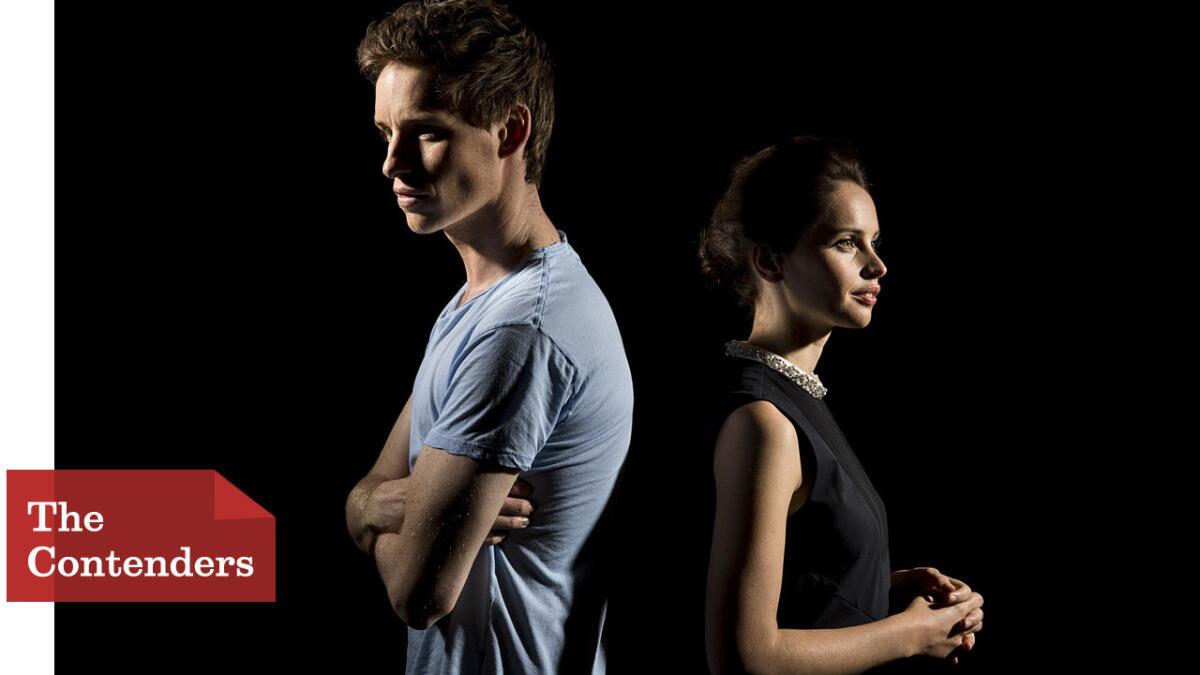The Envelope: Eddie Redmayne, Felicity Jones find mutual orbit in ‘Theory of Everything’

- Share via
Eddie Redmayne and Felicity Jones had an idea — and both will now admit that the notion was “completely bonkers” — on the second day of filming “The Theory of Everything,” the moving portrait of the marriage between theoretical physicist Stephen Hawking and his first wife, Jane Wilde. The actors were shooting a scene that takes place shortly after Hawking is diagnosed with a motor neurone disease (amyotrophic lateral sclerosis, or ALS) in which Jane finds Stephen in his Cambridge dorm and tells him that if he doesn’t play a game of croquet with her, she “won’t come back here again, ever.” Stephen relents, angrily, and you worry what he might do with the mallet once he starts playing.
“It was such an important moment where Stephen is so vulnerable and exposed,” Jones says, “and we wanted to make sure that those emotions came across.” Redmayne, smiling, joins in: “So, while the camera was on me, playing croquet, Felicity was off-camera, shouting abuse at me full-throttle just to throw me off-kilter. It was a way of building trust. But we hadn’t told anyone we were going to do it, so people were looking at us, thinking, ‘Dear God, they hate each other, and it’s only Day 2.’”
Jones laughs. “And maybe the trust wasn’t quite there yet between us, but it was after that. It was the feeling of ‘We’re in this together and we’re going to sink or swim together.’”
It’s safe to say now, a year after filming that scene, that the two made it to shore. “The Theory of Everything” premiered in September at the Toronto International Film Festival, winning strong reviews for its depiction of both Stephen Hawking’s career and a complex, interdependent marriage. Based on the notices and the enthusiasm with which academy members have embraced the movie, Redmayne and Jones could become the first pair of actors playing a married couple to win lead Oscar nominations since Kevin Spacey and Annette Bening for “American Beauty” in 1999.
If that happens, both actors will happily ascribe their success to the collaboration with “Theory” director James Marsh but also with each other. During a leisurely poolside conversation on a recent Sunday afternoon, just before heading over to participate in a post-screening Q&A at the film academy’s Samuel L. Goldwyn Theater, the two Britons formed a mutual admiration society, finishing each other’s sentences, laughing heartily at comic inventions (Jones proposed making “Theory” via the “Boyhood” method, returning to film annually over the course of the 25 years we see the Hawkings) and thanking the stars that they shared a similar acting process.
“We both like to have lots of time, lots of preparation and lots of takes,” Jones, 31, says. “It would have been a nightmare if Eddie ...” And here Redmayne, 32, jumps in (we mentioned this happens a lot): “... if I said, ‘Let’s wing it.’ That would have been rather awkward. What if I only wanted to do two takes?” Jones doesn’t hesitate. “I would have grabbed that croquet mallet and bashed your head in.”
Marsh picked up on his actors’ shared ways of working immediately, encouraging them to play scenes as written several times and then draw on ideas gleaned from rehearsals to try something new.
“Every minute of every day, we were on the precipice of failure, which is an exciting place to be,” Marsh says. “Because being out on that ledge and trusting their instincts, Eddie and Felicity dared to try interesting things that weren’t in the script or weren’t asked for. That off-camera provocation from Felicity during the croquet scene? That wasn’t the only time they did that. But it only works if the actors thoroughly understand the psychology of their characters.”
It’s a psychology that evolves as we follow the Hawkings’ courtship at Cambridge, falling in love at the school’s May Ball in 1963 and then moving through Stephen’s diagnosis and their marriage, which produced three children. The film shows both the toll the disease took on their relationship and the numerous ways they rose above it and triumphed. That’s a lot of ground, requiring a physical and emotional commitment from both actors that was often as thrilling as it was daunting.
The best times of the 48-day shoot (“Beyond short,” Redmayne moans) came when the pair discovered moments on the fly. There was the May Dance scene, in which Stephen and Jane spin each other around, an image that found its way onto the movie’s poster. (“There needed to be an element of dance,” Jones says, “since so much of the movie is about how Stephen’s movement becomes impaired.”)
There were the occasions when they incorporated the humor and vitality that went hand in hand with the family’s challenges, such as when the kids used Stephen’s wheelchair as a go-kart or put naughty words in his voice machine. Or the improvised scene, the final one Jones and Redmayne shot together, in which sitting in bed, Stephen whispers to Jane, “Thank you,” which, Redmayne says, was “one of those weird moments when life and art meet because I was so grateful to Felicity for all she had done for me.”
Of course, after all that, there was still the matter of showing the movie to the Hawkings and nervously awaiting their reaction. Jones phoned Jane, and they talked at length. “She was generous with her praise,” Jones says. Stephen’s review amounted to two words: “Broadly true.” Recently, he updated his thoughts on his Facebook page: “Seeing the film has given me the opportunity to reflect on my life. Although I’m severely disabled, I have been successful in my scientific work. I travel widely and have been to Antarctica and Easter Island, down in a submarine and up on a zero-gravity flight. One day I hope to go into space. I’ve been privileged to gain some understanding of the way the universe operates through my work. But it would be an empty universe indeed without the people that I love.”
“Now that I have a bit of perspective,” Redmayne says, “I’m really left with the transcendent quality of what this family achieved.” Adds Jones: “I hate sounding grandiose, but the story rises above its parts. It becomes about the frailty of being human.”
More to Read
From the Oscars to the Emmys.
Get the Envelope newsletter for exclusive awards season coverage, behind-the-scenes stories from the Envelope podcast and columnist Glenn Whipp’s must-read analysis.
You may occasionally receive promotional content from the Los Angeles Times.











